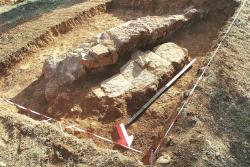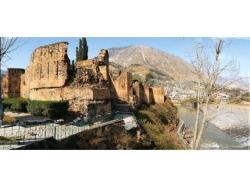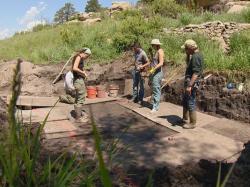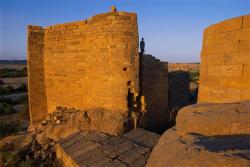INSTITUT SUPERIEUR D'ANTHROPOLOGIE
INSTITUTE OF ANTHROPOLOGY
ONLINE COURSES / COURS A DISTANCE
FALL TERM : OCTOBER 2015
REGISTER NOW
TURQUIE –  Psidia - This season’s excavations have started in the ancient city of Pisidia in the southern province of Isparta’s Yalvaç district. The head of the excavations, Süleyman Demirel University’s Professor Mehmet Özhanlı, said this year’s work would focus on the Temple of Men, which is valuable enough to enter the UNESCO World Heritage List. He said that during the six years of excavations, they had unearthed the ancient city’s main streets. Özhanlı said there were important developments in the structures of the Roman bath, theater and villa, adding, “We have unearthed structures on one of the main streets of the ancient city, Cardo Maximus. The Roman villa was found on the upper part of the street in 2012. This year we plan to start restoration there. We will also work in the southern streets of the city.” The professor said that works will start on the Temple of Men, located on a hill in Özbayat, a village in the eastern part of the district. The area of Pisidia has been inhabited since the Paleolithic Age, with settlements having been built from the eighth to third millennium BC. In the 11th century, the ancient city of Pisidia was captured by the Seljuk Turks. Pisidia frequently changed hands between the Byzantine Empire and the Turks until 1176.
Psidia - This season’s excavations have started in the ancient city of Pisidia in the southern province of Isparta’s Yalvaç district. The head of the excavations, Süleyman Demirel University’s Professor Mehmet Özhanlı, said this year’s work would focus on the Temple of Men, which is valuable enough to enter the UNESCO World Heritage List. He said that during the six years of excavations, they had unearthed the ancient city’s main streets. Özhanlı said there were important developments in the structures of the Roman bath, theater and villa, adding, “We have unearthed structures on one of the main streets of the ancient city, Cardo Maximus. The Roman villa was found on the upper part of the street in 2012. This year we plan to start restoration there. We will also work in the southern streets of the city.” The professor said that works will start on the Temple of Men, located on a hill in Özbayat, a village in the eastern part of the district. The area of Pisidia has been inhabited since the Paleolithic Age, with settlements having been built from the eighth to third millennium BC. In the 11th century, the ancient city of Pisidia was captured by the Seljuk Turks. Pisidia frequently changed hands between the Byzantine Empire and the Turks until 1176.
http://www.hurriyetdailynews.com/season-opens-at-the-ancient-city-of-pisidia-.aspx?pageID=238&nid=83486
PAKISTAN –  Azad Jammu and Kashmir (AJK) and Gilgit-Baltistan (G-B) - A TIAC team recently discovered more than 100 sites of archaeological importance in AJK, 80 of which were damaged by natural calamities in the region. Archaeology and Museums Department Director-General Dr Muhammad Arif advised students to pay serious attention to artefacts found during surveys and unearthed during excavations as primary sources of research, besides review of literary sources. Professor Khawaja Abdul Rehman spoke about the various languages spoken in the Neelum Valley and said that there was lot of lingual diversity in the region. He said Kundal Shahi and Kashmiri languages, which were spoken in the Neelum Valley, were on the verge of dying. Rukhsana Khan said that in Indian Kashmir, more than 700 sites were explored and AJK also had great potential in terms of exploration of archaeological sites. TIAC MPhil researcher Taseer Ahmed said that traditional wooden houses in Baltistan, called Shaaq, were extremely vulnerable and needed immediate attention.
Azad Jammu and Kashmir (AJK) and Gilgit-Baltistan (G-B) - A TIAC team recently discovered more than 100 sites of archaeological importance in AJK, 80 of which were damaged by natural calamities in the region. Archaeology and Museums Department Director-General Dr Muhammad Arif advised students to pay serious attention to artefacts found during surveys and unearthed during excavations as primary sources of research, besides review of literary sources. Professor Khawaja Abdul Rehman spoke about the various languages spoken in the Neelum Valley and said that there was lot of lingual diversity in the region. He said Kundal Shahi and Kashmiri languages, which were spoken in the Neelum Valley, were on the verge of dying. Rukhsana Khan said that in Indian Kashmir, more than 700 sites were explored and AJK also had great potential in terms of exploration of archaeological sites. TIAC MPhil researcher Taseer Ahmed said that traditional wooden houses in Baltistan, called Shaaq, were extremely vulnerable and needed immediate attention.
http://tribune.com.pk/story/897933/up-north-call-for-exploration-of-archaeological-sites/
USA –  Douglas County - Blackfoot Cave is a significant site for several reasons, mainly because there is a source of water there – a spring – which attracted both people and their prey. "Then, the two would converge and there would be hunting and collecting and camping – all of those activities associated with living, subsisting in the past," Carr said. So far, they've found hunting spearheads -- some nearly 5,000 years old -- along with evidence of settlers, who may have traveled through there on the nearby Cherokee Trail. "How we use the landscape is only one component of a much longer and deeper story," Mitchell said. "People have been using this landscape in different ways over a long, long period of time." Colorado State University archaeology students and volunteers are working on the dig, along with staff archaeologists from History Colorado. The site is not open to the public, which is why 9NEWS is not revealing its exact location. Any items excavated will be placed in a historic repository in Douglas County for further study.
Douglas County - Blackfoot Cave is a significant site for several reasons, mainly because there is a source of water there – a spring – which attracted both people and their prey. "Then, the two would converge and there would be hunting and collecting and camping – all of those activities associated with living, subsisting in the past," Carr said. So far, they've found hunting spearheads -- some nearly 5,000 years old -- along with evidence of settlers, who may have traveled through there on the nearby Cherokee Trail. "How we use the landscape is only one component of a much longer and deeper story," Mitchell said. "People have been using this landscape in different ways over a long, long period of time." Colorado State University archaeology students and volunteers are working on the dig, along with staff archaeologists from History Colorado. The site is not open to the public, which is why 9NEWS is not revealing its exact location. Any items excavated will be placed in a historic repository in Douglas County for further study.
VIDEO= http://www.9news.com/story/news/local/2015/06/04/archaeologists-excavating-douglas-county-site/28498309/
BELIZE –  Nim Li Punit - Archeologists and researchers have made a monumental discovery at the Nim Li Punit Archeological site in Toledo. 26 ceramic pots and about 8 pieces of jade were found in a tomb at the site. Today the Director of the Institute of Archaeology Dr. John Morris invited us to share in this find – which is almost as significant as the iconic jade head. Professor of Anthropology, Dr. Geoffrey Braswell is leading the dig and he told me more : "The palace is build in two stages. The first about 400 AD and about 800 it was remodelled we think because one quarter of the building has fallen so they needed to remodel it. Inside that remodel while they were working, they found an early tomb which they probably knew about but didn't expect to hit. So when they finished the final version, they rededicated the tomb, they moved bones around, the made all kind of offerings. Including, we have a bowl full of fingers, probably people cut off their own fingers as sacrifices. We have a lot of evidence of bloodletting the leaving of valuable artefacts. And finally they created the second tomb, they major find of this year.”
Nim Li Punit - Archeologists and researchers have made a monumental discovery at the Nim Li Punit Archeological site in Toledo. 26 ceramic pots and about 8 pieces of jade were found in a tomb at the site. Today the Director of the Institute of Archaeology Dr. John Morris invited us to share in this find – which is almost as significant as the iconic jade head. Professor of Anthropology, Dr. Geoffrey Braswell is leading the dig and he told me more : "The palace is build in two stages. The first about 400 AD and about 800 it was remodelled we think because one quarter of the building has fallen so they needed to remodel it. Inside that remodel while they were working, they found an early tomb which they probably knew about but didn't expect to hit. So when they finished the final version, they rededicated the tomb, they moved bones around, the made all kind of offerings. Including, we have a bowl full of fingers, probably people cut off their own fingers as sacrifices. We have a lot of evidence of bloodletting the leaving of valuable artefacts. And finally they created the second tomb, they major find of this year.”
http://www.7newsbelize.com/sstory.php?nid=32649
YEMEN –  Marib - One of the grandest engineering marvels of the ancient world—the Great Dam of Marib in central Yemen—has been damaged in an airstrike, according to local news reports and archaeological experts in touch with local sources. Ancient Marib was the capital of the wealthy caravan kingdom of Saba (biblical Sheba, home of the legendary queen), which thrived during the first millennium B.C. Along with remains of the Great Dam, considered the most important ancient site in Yemen, excavations of the Sabaean capital have revealed two elaborate pre-Islamic temple precincts dedicated to Almaqah, the chief deity of the kingdom. Thousands of inscriptions identified in Marib are providing researchers with an unusually detailed insight into the kingdom’s laws, institutions, and details of everyday life. From the eighth century B.C. until the fifth or sixth centuries A.D., the Great Dam sustained life in the desert around Marib, the largest city in ancient southern Arabia. The dam’s 50-foot (15-meter) high, 2,100-foot (650 meter) long mud brick retaining wall—almost twice as long as the Hoover Dam—directed monsoon runoff from the adjacent highlands into two sluices that fed a complex irrigation system that could cover up to 25,000 acres (10,000 hectares) of farmland. The Great Dam was breached and rebuilt several times over its millennium of service (one inscription notes that repairs required 20,000 men and more than 14,000 camels), with maintenance becoming even more frequent after the Sabaean kingdom was conquered by the neighboring Himyars in the third century A.D. Sometime between the mid-sixth century and the death of Muhammed in 632, the dam was breached for the final time. The event is mentioned in the Koran, and described as a punishment after the Sabaeans rejected Allah. Images reveal damage the 23-foot (7m) high tower of the northern sluice. It is built of limestone blocks, many of which appear to have been reused from earlier dam constructions and feature ancient Sabaean and Himyarite inscriptions.
Marib - One of the grandest engineering marvels of the ancient world—the Great Dam of Marib in central Yemen—has been damaged in an airstrike, according to local news reports and archaeological experts in touch with local sources. Ancient Marib was the capital of the wealthy caravan kingdom of Saba (biblical Sheba, home of the legendary queen), which thrived during the first millennium B.C. Along with remains of the Great Dam, considered the most important ancient site in Yemen, excavations of the Sabaean capital have revealed two elaborate pre-Islamic temple precincts dedicated to Almaqah, the chief deity of the kingdom. Thousands of inscriptions identified in Marib are providing researchers with an unusually detailed insight into the kingdom’s laws, institutions, and details of everyday life. From the eighth century B.C. until the fifth or sixth centuries A.D., the Great Dam sustained life in the desert around Marib, the largest city in ancient southern Arabia. The dam’s 50-foot (15-meter) high, 2,100-foot (650 meter) long mud brick retaining wall—almost twice as long as the Hoover Dam—directed monsoon runoff from the adjacent highlands into two sluices that fed a complex irrigation system that could cover up to 25,000 acres (10,000 hectares) of farmland. The Great Dam was breached and rebuilt several times over its millennium of service (one inscription notes that repairs required 20,000 men and more than 14,000 camels), with maintenance becoming even more frequent after the Sabaean kingdom was conquered by the neighboring Himyars in the third century A.D. Sometime between the mid-sixth century and the death of Muhammed in 632, the dam was breached for the final time. The event is mentioned in the Koran, and described as a punishment after the Sabaeans rejected Allah. Images reveal damage the 23-foot (7m) high tower of the northern sluice. It is built of limestone blocks, many of which appear to have been reused from earlier dam constructions and feature ancient Sabaean and Himyarite inscriptions.
http://news.nationalgeographic.com/2015/06/150603-Yemen-ancient-Sheba-dam-heritage-destruction-Middle-East-archaeology/